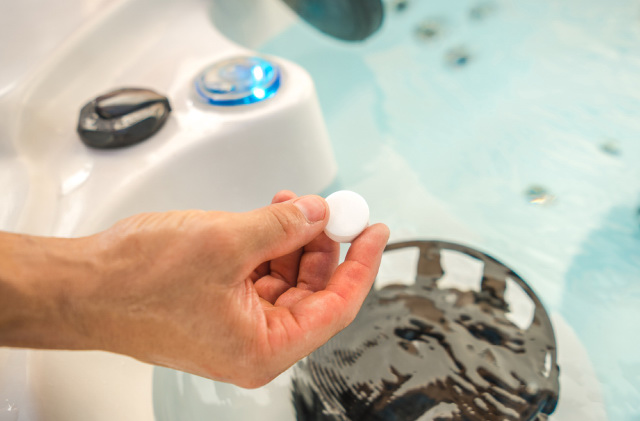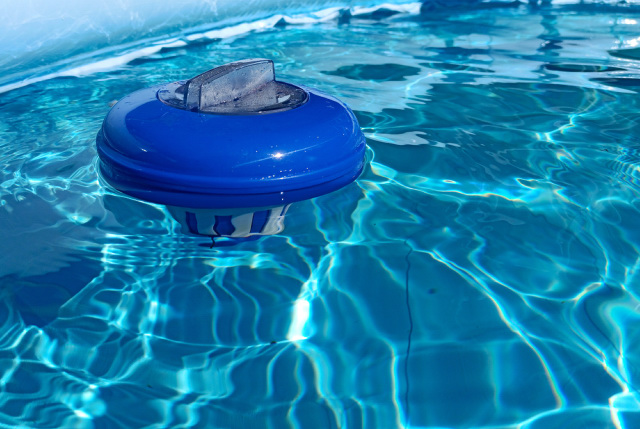Chlorine and bromine are both good choices for a hot tub. But are they safe for you and your family?
Perhaps you want to limit how many chemicals you put in your hot tub. Or you’re concerned about the safety of the chemicals you use. In this article, we’re going to review both chlorine and bromine from a safety perspective.
Both bromine and chlorine are safe to use in a hot tub. Bromine is gentler on the skin and lungs and works better at higher temperatures. Chlorine works more quickly than bromine and is cheaper. Chlorine is better suited to outdoor hot tubs.
Deciding on which sanitizer is best for you and your hot tub can be difficult. So, let’s compare the two and see which sanitizer suits you best.

Article Contents
What is Chlorine?
Chlorine is a common chemical for cleaning and disinfecting household items (bleach) and sanitizing hot tubs and pools. It is highly effective and comes in granular, liquid, and tablet forms.
It cleans the spa by oxidizing (breaking up) bacteria and algae. As the chlorine gets “used up,” it creates chloramines. Chloramines are what people commonly think of as that chlorine smell.
Chlorine has been used as a sanitizer in swimming pools and hot tubs for decades. It is considered safe as long as it is used correctly.
Just like bromine, if the chlorine level is too low, it will not effectively kill bacteria and viruses. If it is too high, it can irritate the skin and eyes. Additionally, chlorine isn’t as stable as bromine, so you’ll need to test the water more often and add chlorine more often to ensure the hot tub is safe.
Chlorine Pros
- Easy to apply
- Works faster
- Cheaper
- Can be stabilized
Chlorine Cons
- Disturbs pH level
- Less effective above 75°F (24°C)
- Frequent applications
- Irritating to sensitive skin and lungs
What is Bromine?
You usually find bromine in a compound such as sodium bromide or potassium bromide. Like chlorine, bromine ionizes (breaks up) bacteria and comes in the same forms: granular, liquid, and tablet.
Bromine has been used for many years to effectively sanitize pools and spas. It is considered safe as long as it is used correctly. If bromine levels are too high, it can irritate the skin and eyes similarly to chlorine.
And if bromine levels are too low, it may not sanitize and kill bacteria. Bromine takes longer than chlorine to kill any dangerous bacteria, so it’s particularly important to ensure bromine levels are not too low.
Bromine Pros
- Fewer applications
- Gentler on sensitive health conditions
- Effective at high temperatures
- Easy to maintain the spa’s pH level
Bromine Cons
- No stabilizing option
- More expensive
- Cloudy water
- Harder to rinse off
If you’re curious about the differences between chlorine and bromine for your hot tub, check out our guide, Chlorine Vs Bromine for Hot Tubs (Which is Better?), for an in-depth comparison.
How Much Do I Need?
If using chlorine, you need a level between 1-3 ppm for optimal sanitation. And, with bromine, it needs to be between 3-5 ppm.
To figure out how much your spa needs, you’ll need to know the hot tub size and the starting chlorine/bromine level. Using a test strip that measures chlorine and bromine, you can easily find that measurement.
Once you know how much you need to raise the level, your chosen sanitizer’s packaging should tell you dosage instructions.
If your hot tub is full of algae or bacteria and your sanitizer level is too low, it’s time to shock your spa. Check out our guide, How to Shock a Hot Tub, for all you need to know!
Which Kills Better: Bromine or Chlorine?
An important to note that when it comes to the safety of bromine or chlorine, you should also take into account which chemical will keep your hot tub sanitized from dangerous bacteria and viruses.
Both chemicals are excellent at killing contaminants. However, chlorine is the more reactive of the two elements, so it kills quicker but doesn’t work as well in typical spa temperatures.
Bromine works slower but longer and is still highly effective at hot tub temperatures.
In the case of chlorine-resistant bacteria (E.coli, for example), bromine is slightly more effective at killing than chlorine. But, bromine still needed the presence of chlorine to rid the organic completely.
So it seems that both bromine and chlorine are safe and effective for killing bacteria and viruses.
Dangers of Chlorine in a Hot Tub
Even though it’s the most common sanitizer for pools and hot tubs, chlorine is still a chemical and comes with risks to your health if misused.
As stated by the CDC website, when chlorine gas comes into contact with moist tissues such as the eyes, throat, and lungs, an acid is produced that can damage these tissues.
It does this by creating toxic compounds called disinfection by-products (DBP) while it’s disinfecting your spa. After prolonged exposure, these compounds can wreak havoc on your organs, particularly the liver.
In one study, scientists tested the long-term effects of chlorinated water on rats. The chlorine level was identical to public pools, and they were swimming for 30-minute sessions five days a week. Not an uncommon frequency for avid swimmers.
During a 12-week intensive swimming program, the rats were experiencing symptoms such as redness and bloodstains around their eyes and noses, indicating respiratory distress. And scientists observed dry, lackluster fur, with the last month showing some hair loss.
Rinsing yourself and your swimwear after chlorinated hot tub use is an important habit to adopt to prevent chlorine effects on your body. And it’s vital to handle chlorine with the respect and care it deserves.
Dangers of Bromine in a Hot Tub
Bromine is a similar chemical to chlorine and has the same long-term effects and dangers.
Inhalation of bromine causes lung irritation and can result in pulmonary edema (fluid in the lung), making breathing difficult.
One in-depth study examined the effects of bromine exposure in humans and animals (mice, rats) and found that bromine is more irritating to the body than chlorine at similar concentration levels.
Aside from pulmonary and HEENT (Head, Ear, Eye, Nose, Throat) distress, bromine exposure can negatively affect other bodily systems.
It can cause headaches, dizziness, shortness of breath, and rashes. Gastrointestinal issues, including diarrhea, vomiting, and nausea, were common symptoms after inhalation exposure.
Is Chlorine or Bromine Safer to Handle & Store?
It’s important to understand that both chemicals used for pool sanitation contain chlorine and are highly toxic in their concentrated form. They can also pose a number of other risks such as fire and or a risk of exploding if not stored correctly.
Whatever sanitizer you pick, proper storage and handling are crucial for your safety, family, and surroundings. Keep your sanitizer in a dry, cool place, out of reach of kids and pets.
Keeping your chosen sanitizer separate from other pool chemicals is vital, as accidental mixing can create highly toxic fumes or become highly combustible. Chlorine should also be kept away from other chlorine types. A dangerous reaction can take place if they come in contact with each other.
The ease of storage and handling will depend on the form (tablet, granular, liquid) of the chlorine/bromine.
With tablets and powder, it’s advisable to wear a mask when handling, as you can accidentally inhale the sanitizing particles and cause lasting respiratory conditions. The Kischers Mask is the ultimate protective mask as it also comes with safety goggles.
If you’re using tablets, consider using a floating dispenser that dispenses chlorine/bromine regularly into the pool with minimum handling.
With liquid chlorine, ensure you wear gloves, regularly check that the container has no leaks, and watch for accidental spillages during use, as skin contact can result in burns, especially if you have curious hands and noses in the household.

Which Is Safer and Which Should You Choose?
Personally, I would go with chlorine, unless you have a sensitive respiratory system. It’s cheaper, more accessible, and all-around easier to use.
Here’s a quick recap of bromine and chlorine’s pros, cons, and relative safety. So which should you pick?
Chlorine – If you’re budget-conscious and have an outdoor tub, then chlorine will be your best sanitizing option. It will be safer outdoors since it can be stabilized.
If you use your hot tub frequently, chlorine, being fast-acting, will kill off any potential viruses and bacteria faster than bromine.
Bromine – Choosing bromine is the better option for your family and pets if you have a household with acute health conditions. Bromine is gentler for people and pets. Also, if you have an indoor spa, don’t use your hot tub often, or don’t mind the cost, the longer-lasting bromine would suit you better.
Related Reading: What Order Should You Add Chemicals in a New Hot Tub? A Hot Tub Start-Up Guide



